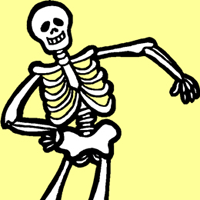|
Try the other way (G# = VI, B = I) Although the way you put it, B can be a bIII which does make a cool sound.
|
|
|
|

|
| # ? Apr 24, 2024 14:06 |
|
Hawkgirl posted:Try the other way (G# = VI, B = I) I've only played them as barre-chords on the guitar, G# - B - G#, but none of them really sound like home/tonic in that context.
|
|
|
|
bIII can have the tonic minor function, so G#-B-G# could just be some modal interchange.
|
|
|
|
This kind of thing is called a chromatic mediant, which is pretty much a non-diatonic version of the mediant or submediant chord. It works because there's a bit of modal borrowing, or has a shared tone, or half-tone movement, or because it's a secondary dominant.
|
|
|
|
https://en.wikipedia.org/wiki/Chromatic_mediant If you like the sound of major chords separated by a minor third, try minor chords separated by a minor third -- another kind of chromatic mediant. E.g, Am to F#m. Or Am to Cm. This sound is featured prominently in the soundtrack for Chrono Trigger. In this video, 8Bit doesn't use the words "chromatic mediant" but every time he talks about m7 chords a m3 interval apart, thats a chromatic mediant. https://www.youtube.com/watch?v=5zGqN1ZOEJQ&t=323s
|
|
|
|
I can tell I'm completely out of my depth, but that just means there's a lot to learn  Thanks. Thanks.
|
|
|
|
You have a lot of sounds in your musical mind, whether you know the labels for them or not. But if you learn the labels, you can have an easier time recognizing it and replicating it. It might seem overwhelming, but we are here to help. Learning to recognize a chromatic mediant and label it is a big step IMO. But before you start exploring the non-diatonic sounds (chords outside the key) you need to know where the different chords in the major scale sit in relation to one another. Learning this was crucial for me to begin understanding music theory. I'll let rio explain it https://www.youtube.com/watch?v=-xRY7CtXRvs.
|
|
|
|
Hi! https://www.youtube.com/watch?v=r9LCwI5iErE 8:36 but watch the whole thing Later!
|
|
|
|
I had seen this years ago, before I studied music theory. But watching it again, today I learned that a "Deceptive Cadence" is actually a broadly defined term that applies whenever you follow a dominant chord with something other than its tonic. I had assumed that V -> vi (e.g., G7 -> Am) was the only kind of change that counts as a deceptive cadence. But, for Benjamin Zander at least, thats but one possibility.
|
|
|
|
Do Sus-chords have any kind of job/defined function in functional harmony? If you play Dm - Dsus2 - Dsus4 - Dm it sounds like a lot is happening. But functionally speaking, aren't you just hanging out on the same chord in the key?
|
|
|
|
The most salient thing about sus chords is that they don't have a minor 3rd or major 3rd in them. That makes it possible to work them into lots of potential places in your music. In the context of functional harmony, there's not much to say about Dm - Dsus2 - Dsus4 - Dm, because you don't cadence to a different chord. So you're right, from this standpoint, you're staying in the neighborhood of D minor. The musical interest comes from the creation of a melody line when you go thru these chord changes. All the notes in the chords are the same except for this F - E - G - F melody you get from the minor 3rd going down to a major 2nd, going up to a perfect 4th, and back down to a minor 3rd. Meanwhile, the other notes stay the same, creating a kind of drone effect. Those non-moving voices provide a nice contrast to the movement in the melody. In a classical music, you would most often find a sus chord used as a passing chord going from the dominant to the tonic. So for example, play G -> A7 -> Dsus2 -> D to get that kind of sound. When I play that using open chords on my guitar, the sus2 voice in the Dsus2 is an E. And that same E note is in the A7 chord just before the Dsus2. The voice singing the E in the A7 chord is "suspended" for a little bit after the rest of the voices have moved onto a D chord. Eventually, the E resolves up a whole step to an F#, completing the resolution. In a modern context, there are LOTS of different ways to use the sus chord. Too many for me to talk about in this post. I'll refer you to Rick Beato for more on that. https://www.youtube.com/watch?v=KmpDxDzKhCE
|
|
|
|
Pondex posted:Do Sus-chords have any kind of job/defined function in functional harmony? It depends on genre, I think - can't speak to classical, but in jazz the V7sus4 can be either subdominant or dominant, depending on context. Herbie Hancock uses them extensively in Maiden Voyage as well.
|
|
|
|
Okay, this is buggin' the poo poo out of me. (This is a pic from some Amazon card set review and it triggered me to post this)  The root notes are red. How is A the root note on an E Scale? I've been seeing this all over the place where they highlight the root notes on the scale, and they don't match the key of the scale. Why.
|
|
|
|
I think it's just poorly designed. Isn't that the A blues scale anyway? It's not saying the scale is in E, it's just saying "here's the root note of the A blues scale found on the E string and here's a few other roots"
|
|
|
|
Kvlt! posted:I think it's just poorly designed. Isn't that the A blues scale anyway? It's not saying the scale is in E, it's just saying "here's the root note of the A blues scale found on the E string and here's a few other roots" They should've left the neck markers off so it was more obviously a generic shape.
|
|
|
|
Philthy posted:Okay, this is buggin' the poo poo out of me. That isn't the E scale, it's the E shape. If the root note was E and you played the chord tones, then you'd have the basic open E chord. This comes from what I know of as the CAGED system, where you have 5 shapes based on the 5 open chords, and everything, from major, minor, modes, etc, are all derived from these shapes. For example, the most basic F chord most people know with the root as 1st fret on the E string, is in the E shape. Take that shape and move it up and down the fret board. That note on the E string will always be the root, but you could be using the E shape to play an A scale if you start on the 5th fret, for example. Which is what your image shows. As a teenager I used to just practice those shapes, for all 7 modes, plus harmonic and melodic minor, in every position on the fretboard when I was doing other things like watching TV until it was all muscle memory. Konsek fucked around with this message at 00:00 on Dec 14, 2018 |
|
|
|
Kvlt! posted:I think it's just poorly designed. Isn't that the A blues scale anyway? It's not saying the scale is in E, it's just saying "here's the root note of the A blues scale found on the E string and here's a few other roots" Yeah. The root is on the E string and it's an A. That's poorly thought out.
|
|
|
|
Ok so I'm trying to understand this song; https://www.youtube.com/watch?v=z6DRqz4SbrQ So it is in the key of C major, and I've come sort of halfway there in figuring out the chord progression. So intro/stick is just a simple Am, which is the VI Verse goes Am / Em / G (VI / III / V) Then it comes to the bridge which has a Bb, and it isn't part of the scale, what does that make that particular chord? There's also a D# in the chorus which also doesn't belong to C major, so my question is ; How does this work (if this is understandable at all)?
|
|
|
|
Pretty sure it's in A minor in the verses and that it modulates to Bb major (? I'm just guessing, I didn't check  ) in the chorus. ) in the chorus.
|
|
|
|
Hawkgirl posted:Pretty sure it's in A minor in the verses and that it modulates to Bb major (? I'm just guessing, I didn't check omg get your head in the game Greggster posted:Ok so I'm trying to understand this song; I feel it modulates from A minor to F major. F major is the submediant (VI chord) of A minor. It's the subdominant (IV chord) of C major. To my ears, F major is a perfectly natural place to go to from C major, but its a weird place to end up after hanging around in A minor. But yeah, you're right that the Bb is at home in the key of F major, but it's not at home in A minor at all. From a theoretical functional harmony standpoint, C major "cadences" nicely into F major because C is the dominant (V chord) in the key of F major. But A minor doesn't really cadence nicely to F major. They coexist diatonically in C major or A minor, but its a distant relationship compared to A=>D or E=>A. And the song doesn't give you a C major chord to set up the transition. The A minor section borrows the E major (V chord) in place of the diatonic E minor (v chord). The F major section borrows the A major (III chord) instead of the diatonic A minor (iii chord). They're borrowing from A harmonic minor and F harmonic major respectively. So in addition to the unusual move from Am -> F, we're getting these chromatically altered chords in each section. Overall this is going out of its way to sharply contrast tonalities in the two parts, and it either avoids or neglects a transition. It's using the harmony to go from this negative attitude in the first part to more positive lyrics and attitude in the second part. I see what its doing, but it's way too abrupt for my taste. Helianthus Annuus fucked around with this message at 07:44 on Dec 14, 2018 |
|
|
|
If the chorus has an Eb then itís probably F mixolydian, which is more common in pop than major anyway. I am a teacher and itís literally the last day before winter break, give me a break man  
|
|
|
|
Bb isn't at home in A minor, but bII is a legitimate subdominant chord for a minor key. Wayne Shorter's used it. It usually only appears as a lead-in back to the tonic minor though, which isn't happening here. The chorus could be in F mixolydian, due to the Eb, but that would depend on two things: the frequency of Eb, and whether or not C is used. There's no C major in F mixolydian, due to the Eb. If there's a lot of back-and-forth between F and Eb, and F is clearly the tonic (which it is, you can hear it), then it would definitely be F mixo. Which is really just a convoluted way for me to say I can't tell.
|
|
|
|
There's at least one C major chord in the F major section. But I don't remember hearing an Eb chord.
|
|
|
|
Hawkgirl posted:I am a teacher and itís literally the last day before winter break, give me a break man music analysis is much lower stakes lol are you a guitar or piano player? i can't analyze music at all without playing along on my guitar.
|
|
|
|
Helianthus Annuus posted:music analysis is much lower stakes lol Iíve got some piano chops, but I just went off the description and made some guesses honestly. In retrospect modulation to F major and/or mixo makes WAY more sense than a mod to Bb major, but whatevs. Iím a flute/horn/vocalist person by trade
|
|
|
|
i wanted to post this because he talks a lot about modulations and how to set up a satisfying transition to distant keys https://www.youtube.com/watch?v=bPPqMnf91VY
|
|
|
|
Hawkgirl posted:Iíve got some piano chops, but I just went off the description and made some guesses honestly. In retrospect modulation to F major and/or mixo makes WAY more sense than a mod to Bb major, but whatevs. recommend you try transcribing songs on piano to level up at applying music theory to things you hear it just better be a song you love, because holy poo poo will you have to hear a lot of it to transcribe it
|
|
|
|
Helianthus Annuus posted:recommend you try transcribing songs on piano to level up at applying music theory to things you hear Legitimately good advice, but Iím supposed to be creating a middle school level intro to playing chorales book for a grad school project that will achieve roughly the same musicianship goals, so Iíll probably do that first. Or, you know, video games.
|
|
|
|
Helianthus Annuus posted:omg get your head in the game Oh alright! Thanks a lot for the detailed response, it is incredibly helpful and I found it very understandable  It is funny you should mention that you're not fond of the abrupt change because it is exactly that abrupt change I am so in love with and it's the reason why I try to dissect it so that I can apply that knowledge somehow in my own music. It is funny you should mention that you're not fond of the abrupt change because it is exactly that abrupt change I am so in love with and it's the reason why I try to dissect it so that I can apply that knowledge somehow in my own music.Helianthus Annuus posted:There's at least one C major chord in the F major section. But I don't remember hearing an Eb chord. The Eb chord is the second last chord in the chorus (I put it down as a D# because the chord before that is a D, and from what I sort of remember from when I first learned music theory you're supposed to sharp the chord if you go up, so if you go from a D and up half a step it becomes a D# but if you down, you write it as Eb if you went down from, say E.) Or at least I think so, I come from a rock guitar background where essentially the only chords I play are power chords and usually just do melodies in minor scale  Helianthus Annuus posted:i wanted to post this because he talks a lot about modulations and how to set up a satisfying transition to distant keys This is incredibly cool and really helpful, thanks a lot for the video!
|
|
|
|
Different people like different things in music, for example, here's something I transcribed recently that I really like, although I suspect others might not care for. https://www.youtube.com/watch?v=PYJ0fbF6XwY I think the verse goes: D -> Dmaj7 -> D7 -> G Gm -> Bm -> E -> Em And the chorus: F#m -> Bm -> E -> Em The G -> Gm is a parallel minor chord change. It happens again with E -> Em. These work for me in this song. You can find a lot of parallel minor chord changes in radiohead too I really like the D -> Dmaj7 -> D7 -> G thing in here. I dig that kind of chromatic voice leading thing where you walk down from the octave to the 7 to the flat 7. It's also good to do in minor, like in the bridge of Guitar Man: Am -> AmM7 -> Am7 -> D
|
|
|
|
D-DM7-D7 is what they apparently call a "line cliche"; they use it to give a sense of progression to lengthy sequences of a single chord. The most famous example, I think, is the James Bond theme. But you can find it in The Beatles, a lot of jazz, even songs like Fly High Michelle. In that case, they do a good job of ramping up tension before the chorus.
|
|
|
|
Jason Sextro posted:D-DM7-D7 is what they apparently call a "line cliche"; they use it to give a sense of progression to lengthy sequences of a single chord. The most famous example, I think, is the James Bond theme. But you can find it in The Beatles, a lot of jazz, even songs like Fly High Michelle. In that case, they do a good job of ramping up tension before the chorus. It's also an example of play a chord and move your pinkie around (as coined by Michael Stipe, I think) The verse for Find The River for instance is written out as D-Dm-Dsus2-D7sus4. It is actually, play a D chord, move your first finger to the first fret, move your first finger to the third string, drop your pinky on the third fret, bottom string, start over, add a little frill on the e-string, play the chorus. So the bottom string goes 2nd fret, first fret, open string, third fret, return to second fret and continue while everything else is almost all the same. In this case the Chorus is G-A-Emi-D so you contrast a harmonically compressed verse about feelings of entrapment with a wide open chorus about escape. D-DM7-D7 is D, Move middle finger down a fret, move middle finger down a fret (this would feel awkward though), oh hey your top 2 fingers are in the exact angle they need to be for a G chord, just move them to the apporiate frets. fake edit: Yeah, I just fingered this out, it's not possible to play like that (you need to swap fingers on the 2 high strings going DM7-D7 to make it work) BUT! The B (second) string shows off the cliche beautifully going 3rd fret, 2nd fret, 1st fret, open string. Most of the other strings don't change actual edit: Turn the Dsus2 in the Find the River verse to Asus2. Now only the high E string changes, while the chord remains static. Jonny Nox fucked around with this message at 21:31 on Dec 18, 2018 |
|
|
|
thats like... a line cliche and a parallel modulation in the same thing!
|
|
|
|
Hi gang. I have a lot of bookmarks (in books) and a bunch of loose leaf stuff around to try and make sense of theory, but always just wanted a big at a glance thing. Looked around and couldn't find what I wanted all in one place, so I made a thing. Disclaimers: I do not have any classical theory training I do not own illustrator and just learned a bit of inkscape specifically for this task. Posting to share, freely give the horribly managed .svg if anyone would like and to get some feedback. Intention is to print this out on a 24x36" to have up and reference at home. 1. If I am horribly mistaken on anything (theory wise) would be happy to hear it. 2. If I am horribly wrong design wise from a vector making standpoint (png is linked) or otherwise a design failure would be happy to hear it 3. If there is any other useful info that could / should be added here I would be glad to hear it. Everything was done from scratch / no screen shots from existing sources so its copyright free. Thanks for the feedback. If anyone wants the vector, I'll find some place to upload it and whoever can do whatever. 
|
|
|
|
|
Basic Poster posted:Hi gang. I've been looking for something like this for reference. Would love to be able to get a high quality print size. I've been studying theory the last two months, but can't play piano so can't memorize them that way. Having a reference while working in Ableton is super useful so I don't end up having to waste time calculating scale notes and such.
|
|
|
Hamelekim posted:I've been looking for something like this for reference. Would love to be able to get a high quality print size. Here is a link to DL the .svg. Its in 24x36 which is basically movie poster size. https://megaupload.nz/L2pbGcpbb1/commonPracticeChartb_svg
|
|
|
|
|
Basic Poster posted:Here is a link to DL the .svg. Thanks!
|
|
|
|
I started using this app to brush up on some theory stuff, and one of the 'games' in the app is interval generation -- i.e., given a note, name the note that's a perfect fourth/fifth/whatever up/down from it. I understand how to do this, but there *has* to be a faster method than the one I'm using. I either just count the semitones or picture part of the fretboard of a guitar. I've done hours and hours of this and it still takes me 15-30 seconds for each question though. Do I really have to just memorize all of the melodic intervals for every note? Or is there a better way to do this?
|
|
|
|
Disclaimer: I'm not great at intervals but I know a few tricks from when I did regularly practice them. I use a lot of benchmarking. Like I know C to G is a perfect 5th. So if you lower by one semitone, B, then your perfect 5th is Gb/F#. C to anything is fairly quick for me because I did a lot of piano, but made it hard to think chromatically. Another trick is that the inverse interval adds to 9, a perfect 5th up is a perfect 4th down. Keep in mind unison is 1, though. But you need to keep in mind major/minor for non-perfect intervals. The major 7th up, is a minor 2nd down. Circle of 5ths help a lot with benchmarking all your perfect 5ths, but all your perfect 4ths as well. I know there's a trick for the others, but I'm phone posting. It's amazing how much is embedded into that thing.
|
|
|
|
|

|
| # ? Apr 24, 2024 14:06 |
|
Gnumonic posted:I started using this app to brush up on some theory stuff, and one of the 'games' in the app is interval generation -- i.e., given a note, name the note that's a perfect fourth/fifth/whatever up/down from it. What's the name of the app? That sounds like something I'd be into.
|
|
|





















